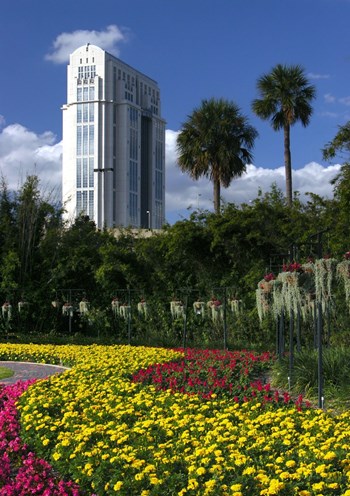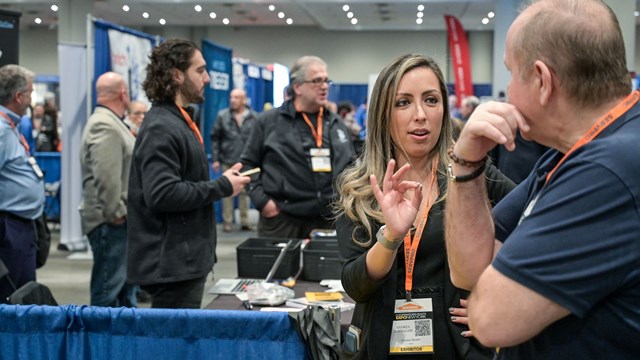
South Florida is well known for sunshine, sandy beaches and lovely landscapes. The ever-growing backdrop of native plants is often studded with pops of color and graceful palm trees. Sun, soil and water requirements dictate what will bloom best in any given location, but even naturally lush landscapes need care and attention to maintain optimum beauty and health. The proper mix of elements doesn’t happen by accident even in semi- tropical South Florida, where the growing season is pretty much all year long.
Winters are a brief, usually dry, few weeks, and the summer rainy season coincides with the annual hurricane season. South Florida landscapers must deal with these adjustments, and the occasional drought, just like states to the north face the challenges of snow and ice.
Condominium and homeowner associations typically find landscaping and lawn maintenance expenses are second only to insurance cost; fortunately the benefits of a thriving landscape continue to outweigh the expense. Property value, real and perceived, is enhanced by an attractive landscape, and residents tend to take more pride in their homes. Additionally, a well manicured landscape is an added benefit when units are placed on the market.
Maximizing the Elements
“Using native plants, in the best possible location with proper sun exposure and irrigation is a smart and economical way to maximize a landscaping budget,” says Michael Cihal, vice president of operations and a certified horticulturist for Total Landscape Concepts, Inc. in Pembroke Pines. Cihal has a heavy design background, and particularity enjoys creating landscapes for high end properties; he gravitates towards unusual and unique native plants.
When working in confined areas, Cihal pays close attention to the space and the lighting, both are issues as plants mature. He favors dwarf varieties of native plants, understory palms, and other unusual palms. “There is a narrow margin on temperatures and moisture for many tropical plants, if temperatures fall below 60 degrees or water is restricted, plants can decline quickly without protection,” he says.
Cihal strives for a controlled look for property entrances, and a freer, more tropical style for back property areas. “St. Augustine strains are the most common grasses for lawns, but Bermuda and Zoysia turfs are also good choices in South Florida. They are tolerant of wind, salt, and high temperatures”.
Cihal advises there are not a lot of nutrients in Florida soil, and a total package of feeding, maintaining, fertilizing, and controlling irrigation is key to keeping plants and turf healthy and beautiful. He spends time with Boards and committees sharing information and educating his clients. “People may prefer the plants they loved in their hometowns, but those plants may not perform well in a tropical zone. If you do not plan, you spin your wheels,” he advises.
Charles Gonzalez is a vice president and regional manager for ValleyCrest Landscaping. With more than twenty years experience in tropical and sub-tropical climates, Gonzales also knows the value of planning. “Pay attention to plant groups, he advises. Native plants with similar requirements for water, soil, and light, can work well together.”
Gonzalez likes to use small leaf plants, and dwarf varieties in compact areas, and recommends using color and originality for entrances in order to make a design impact. In areas such as parking lots that typically experience more wear and tear, he favors trees, like a native royal palm or even an oak. “Trees will give you the best bang for your buck in a parking lot setting,” he states. Gonzalez recommends remembering the sense of smell when landscaping around walking and biking trails; plant fragrant flowers and shrubs to enhance those areas. When it comes to lawn and turf grasses, he favors Zoysia, St. Augustine, and Floratam grasses. Zoysia is slower growing and needs less water.
Properties adjacent to the ocean often have to deal with the corrosive effects of salt water. Gonzalez recommends native coco palms for an upscale design that is also salt resistant. Plants for pool areas should be chlorine resistant varieties such as Ficus, but most mature plants can also withstand moderate amounts of pool water.
Pet waste however is another matter; dog urine can be deadly to flowers, shrubs, and lawns. Gonzalez has noticed some properties use gravel or natural stone for dog walks, solving the problem and creating an attract texture to the landscape. Artificial turf is also a possible solution for easy clean up of pet waste.
Gonzalez is always pleased when a client has a clear vision and a desire to understand and partner with a landscape expert. He focuses on training and educating on everything from pest control, to extra plant protection when temperatures plummet. “Landscaping is the first and the last impression when viewing a property. An ideal client will have a good grasp of a realistic budget, and follow up maintenance investment,” he says.
Scott Prinz, owner and president of LandKeepers, Inc. in Miami is in agreement with Gonzalez on the need for a client to understand a total landscape budget commitment. “It is easy to gravitate towards the wow factor, and overlook the hidden long term cost of maintenance”, he says. Prinz is available for consults and to answer specific questions and concerns. He has twenty eight years experience in the Miami-Dade area and understands the South Florida climate. Prinz uses high end plants, trees and shrubs for maximum curb appeal at property entrances, particularly if there is an isolated island to ensure protection from traffic. When working in small or controlled spaces, he advises against spreading plants. “They may be cute and little now, but pay attention to height and width growth patterns,” he says.
Prinz recommends using plants and landscaping to guide traffic patterns through a property. “Using a planter with a pop of color, or well placed small hedges can control foot traffic,” he explains. “The beauty of South Florida is the variety of plants, palms, and color available year round, including trees and variegated greens.” Prinz uses hedges for a more formal look, but notes Ligustrums can be fun. This versatile, mid-range shrub can be used as a hedge or a decorative tree, trimmed for a formal or a whimsical setting.
“Normal splash activity is not the problem for plants in a pool setting, he states. But back-washing the filters can be.” Prinz recommends using long hoses to divert chlorinated water away from turf and plants.
Adam Baker, CEO of Broward Landscape, Inc. emphasizes the point made by Cihal, Gonzalez, and Prinz. “Landscaping in Florida will always be a work in progress. Having an ongoing working relationship between the Board and the landscape contractor or property management firm is key,” he explains. Baker and his team of professionals have over 17 years experience in commercial and residential landscaping in South Florida. He covers everything from soil testing to design in order to enhance the natural tropical beauty that is South Florida.
Landscaping and ground maintenance is not a do-it-yourself- committee project for most tropical South Florida properties, but Board and committee members who wish to educate themselves have excellent resources. A database of Florida-friendly plants may be located online at www.floridayards.org. This easy to use source contains information on 380 species of flowers, vines, grasses and ground covers as well as trees and palms.
Additionally the University of Florida IFAS Extension Services has an informative site, dade@ifas.ufl.edu with information on landscaping, and access to Master Gardeners.
Anne Childers is a freelance writer and a frequent contributor to The South Florida Cooperator.




Leave a Comment